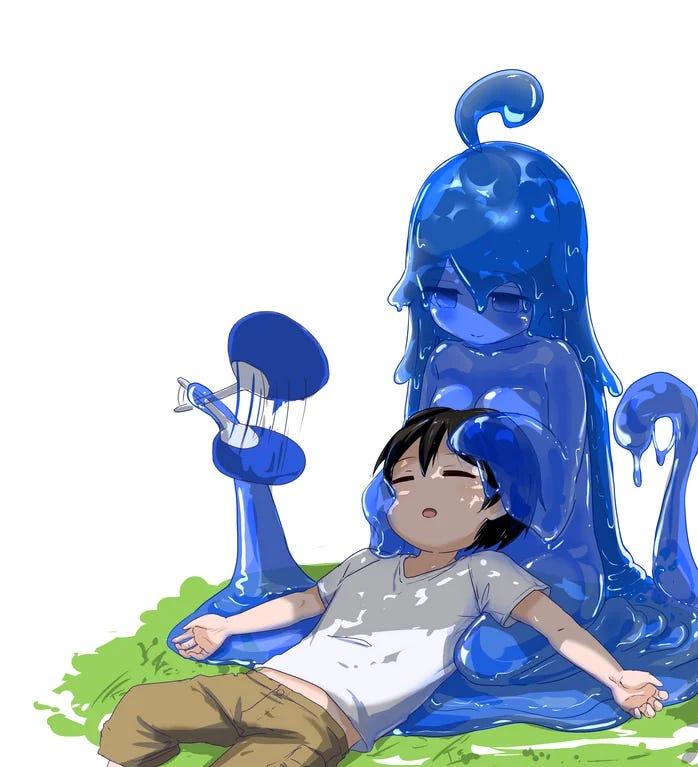Who amongst us inculcated into the structure of masculinity hasn't at some point entertained the thought of a sentient elemental slime enveloping us entirely only to dissolve us in disintegrating, horrific bliss?
Slime girls are a flowering of the mighty Japanese imaginative spirit who, in one sense, represent the logical endpoint of heterosexual pornography at the limit of the fantasy of complete fusion with the other whilst still retaining the male subject's coherent form. Let's examine this phenomenon a little and see what emancipatory potential may lie within a future of slime girls.
Slime is, in its essence, multivalent and somewhat uncanny. As a physical substance, it is non-Newtonian and has properties of both liquids and solids. In human relations, it suggests moral defects or untrustworthiness as well as endearment and trust. In many places, the barrier that buffers us from the world's hostile tendrils is slime, the same form of matter that lubricates us when we are compelled to engulf something from the outside. We can see slime in the invisible webs of finance capital that permeate the globe and in the perpetual instability of our liquid modernity. Oozing and diffusing, slime is always in a state of becoming. But liminality is tired now and wants to rest as a worn-out term; let's instead think of slime as the fertile residue of water and earth combined, the smushing-together of Thales and Parmenides, something fundamentally genesitical.
Slimes are also a common trope in certain fiction and games, and ubiquitous in Japanese RPGs as low-level gelatinous enemies. Monster girls, on the other hand, are part of a genre humanizing traditionally monstrous beings, making them endearing or attractive somehow: demons, minotaurs, harpies, lamias, spiders, gorgons, zombies, ogres, kitsunes, wasps, sharks, and so on. Slime girls, a subset of monster girls, are, therefore, an archetype of typically human-shaped gelatinous and sentient, attractive creatures, primarily transparent, who are able to adapt to any shape. They embody a certain traditional feminine ideal -- soft, yielding, nurturing, fluid -- in the most visually visceral way. Yet there is horror in any standpoint taken to the extreme, and so slime girls necessarily hover between intimacy and consumption; the yielding feminine becomes the consuming abject, a primordial devouring ooze, pure shapelessness itself.
Monster girls are, of course, often sexualized in the objectifying artistic traditions they spring from, and slime girls are not an exception. We thus have at our disposal an industry creating images where slime girls play with flesh boys. Their erotic appeal appears to operate precisely in the space between pure desire and horror. Of course, at the very surface level, slime girls offer the possibility of maximal sensual stimulation: They can softly touch you everywhere at once, be penetrated (anywhere) and penetrate you (whilst retaining their femininity and your masculinity), take your fluids and recycle them back into you, take your cravings and have them echoed and amplified in an amniotic, often green or blue or purple, cocoon of bliss. Moreover, they can take any shape you crave. Do you fetishize exercise bikes, giant slippers or garden sheds? Now, you can plunge into the inviting softness of a semblance of one any way you choose.
But at a more fundamental level, if we, for example, follow psychoanalyst-cum-philosopher Jacques Lacan a little, we can think of any sexual melding with this creature of complete softness and yielding as enacting the impossible fantasy of complete fusion with the Other. The restless subject, finally, finds a way to overcome the fundamental lack and separation that is nonetheless (in that tradition of thought) seen as constitutive of a subject itself. At the same time, the fantasy of complete melding carries the horrible dimension of having to dissolve one’s ego and lose all subjectivity. We might then associate the slime girl with the Lacanian Real, a being that simply cannot be fully integrated into the symbolic order, her oozing body overflowing any boundaries of signification. Nonetheless, often in erotic scenes depicted with a slime girl, a crucial detail, impossible with other intimate partners, is added, and it serves to push this fantasy to its greatest extreme: because of the transparency of the girl's body, the male member can be seen in its entirety in the act of penetration.

This visual gesture, also discernable in Japanese-style sexual art where human bodies are portrayed in cut-away silhouettes showing the sexual organs in contact, allows the male to see himself, so to speak, in the act of fusion, maintaining his position both as subject and object of the gaze. Even in this closest moment of intimacy, the spectatorial dimension is preserved, and the separateness of the male form is maintained, warding off ego death whilst allowing one to enjoy the thrill of dissolution (see also the prevalence of creampies and fetishes around viewing into orifices for instances of attempting to keep hold of visual mastery even in moments of intimate union). But the irony here is profound: "Seeing everything" functions as a defence mechanism against genuine intimacy and inner experience, a maximization of the male gaze. It is a method for the male subject to sidestep the anxiety of the unpredictability of a genuine encounter with otherness and interiority, a disavowal of and defence against feminine enjoyment, feminine jouissance. Real intimacy requires enduring uncertainty, unknowability, and loss of control in a way that the slime girl fantasy precludes. In appearing to get everything, the male subject gets nothing at all.
We might see this pattern of privileging external confirmation over felt experience and risky, intimate encounters elsewhere, too: In the visible metrics of dating apps (height, weight, income, algorithmic match percentages), the before/after photos of fitness culture, the smart rings quantifying your every breath, the humming, transparent glass towers broadcasting productivity in the Central Business Districts of the world. We have been, and remain, so very ready to go far to avoid the danger of a real human encounter. But can we find a way for the spear that tears open the wound to heal it, too? And can we do it without falling into the other extreme, of celebrating precisely what the male subject's fantasy here is guarding against -- the boundless proliferation of slime girls as depicted above, as non-organized surfaces of pure intensity, a barren body-without-organs, a universal becoming-slime that is just a multiplication of what we see already? Let's push deeper into the essence of slime girls to see what more can be gleaned.
Thankfully, slime girl lore goes beyond just sexual depictions, and in more sophisticated slime girl narratives, they develop from just abstract negations of form or reductions as transparent vessels into more self-conscious beings with a deeper interiority. In Monster Musume, Suu comes to us first as a purely mimetic, instinctual being, but as the story progresses, she is able to develop an increasingly complex self-consciousness aided by her ability to absorb knowledge through physical contact and general sharp intellect. Instead of transparency being used to defend against otherness, the slime girl's fluid nature is a way to explore genuine otherness and the development of subjecthood. Similarly, the male protagonist Kimihito (Darling, Master, Milord, Honey, Loverboy, Snookums) must learn to relate to Suu as a genuine other, not just a see-through vessel for his own fantasies.

In That Time I Got Reincarnated as a Slime, the rather genderless Rimuru undergoes a fundamental development from human to slime to slime humanoid (ultimate slime / Dragon Demon Viscous Star Divine Body). The initial, catastrophic loss of human form becomes the very ground for a higher form of selfhood. By confronting the loss directly, the exact qualities that make slime girls threatening in erotic fantasy -- the fluidity of their boundaries, their boundless capacity for absorption and transformation -- become the basis for a more advanced form of conscious self-determination.
Then, in Shoujo Shuumatsu Ryokou (Girls' Last Tour), the two protagonists meet some Goo Girls, who appear portrayed, in part, as metaphors of adaptation to a post-apocalyptic world where they balance flux and identity and point to a future where humanity as we know it can no longer endure. However, these encounters also get the protagonists, Yuuri and Chito, to reflect and develop. The fluidity of form coupled with a developing inner life is shown to elevate slime beyond the standard human. It is here, in the more sophisticated slime girl narratives, where we see a hint of how the maintenance and development of mysterious interiority can couple with intimate fusion, a better balance of revelation and concealment that we are able to access better only having faced the dead-end of pushing into pure slime qua slime. As we see in the high-concept world of Monster Musume, a slime girl interacting with a community and its ongoing ethical life is able to develop both herself and the male subject interacting with her, elevating both and showcasing a way of being that is able to set its own self in a fundamentally deeper way than a mere human.1
In the future of slime girls and their apparent formlessness we may thus read a higher form of determinate being, one that is able to incorporate negation within itself in a more self-determined way. We know that freedom is not the absence of determination but the capacity to determine oneself through the process of transformation. So, the future of slime carries within it not just the boundless plurality of pornographic scenes but also the capacity for a higher realisation of life itself. As we dream of expanding both through the cosmos outside our blue world and the ever-faster computed realms within it, endangered by the loss of self that vast distances and timescales threaten to bring us, may we one day do so as fully realised slime.
Slime Girl - Spoken Word over S.W.A.K - Luxury Elite
To be sure, this balance between form and formlessness has been grappled outside of Japan, too. In anime, games and manga, depictions of fluid dissolution and individual consciousness reach in visual form towards what, for example, Virginia Woolf's The Waves accomplishes in modernist prose. The language of the work performs the movement between form and formlessness we see on the screen as the six individual voices blend in movements in both directions. Moreover, we encounter the blend of selves already in Ovid, where Salmacis and Hermaphroditus famously meld in the waters.





